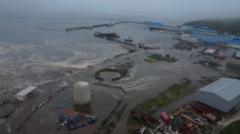The Pacific region is reeling under tsunami alerts following a powerful 8.8 magnitude earthquake that struck near the Kamchatka Peninsula in Russia. Occurring at approximately 11:25 AM local time (00:25 AM BST) on Wednesday, this quake is said to be among the most intense ever recorded.
In response to the natural disaster, millions of residents across Russia, Japan, and sections of the US west coast have been ordered to evacuate. Warnings also spread to several other nations, including China, the Philippines, Indonesia, New Zealand, and even reaching as far as Peru and Mexico.
Eyewitness accounts and videos from the Russian town of Severo-Kurilsk depict large waves crashing over buildings, submerging the port and a fish processing facility. The local power grid suffered damage in the Sakhalin region, escalating concerns about the safety and well-being of residents.
In Japan, authorities have evacuated approximately 1.9 million people, with many seeking safety on higher ground or roofs in the Hokkaido region. As tsunami waves are anticipated to reach up to 10 feet in Hawaii, Governor Josh Green stated that no significant wave has been observed yet, and it may take several hours for officials to declare an all-clear.
Experts remain cautious in predicting the scale of the disaster, as tsunami waves continue to travel across the Pacific. Chris Goldfinger, a Professor of Marine Geology at Oregon State University, noted that current models are being refined to better understand the potential impact. The outcome depends on the energy's trajectory radiating from the earthquake’s epicenter, with areas directly along its path expected to bear the brunt of the impact.
The earthquake's immediate effects on the United States are anticipated, with potential waves projected to arrive in British Columbia and California around 12:20 AM local time (09:20 AM BST), reaching Nome, Alaska by 03:20 AM (12:20 PM BST). Experts emphasize that tsunami waves can travel at jet speed, underscoring the urgency of preparedness.
This earthquake, recorded at a depth of 19.3 kilometers (12 miles) and located 119 kilometers east-southeast of Petropavlovsk-Kamchatsky, is currently tied for the sixth-most severe quake in recorded history. Significant aftershocks have also been noted. Comparatively, the devastating 2004 Indian Ocean earthquake, which reached magnitudes between 9.2 and 9.3, caused monumental loss of life, making the current situation all the more pressing for citizens and officials alike.
In response to the natural disaster, millions of residents across Russia, Japan, and sections of the US west coast have been ordered to evacuate. Warnings also spread to several other nations, including China, the Philippines, Indonesia, New Zealand, and even reaching as far as Peru and Mexico.
Eyewitness accounts and videos from the Russian town of Severo-Kurilsk depict large waves crashing over buildings, submerging the port and a fish processing facility. The local power grid suffered damage in the Sakhalin region, escalating concerns about the safety and well-being of residents.
In Japan, authorities have evacuated approximately 1.9 million people, with many seeking safety on higher ground or roofs in the Hokkaido region. As tsunami waves are anticipated to reach up to 10 feet in Hawaii, Governor Josh Green stated that no significant wave has been observed yet, and it may take several hours for officials to declare an all-clear.
Experts remain cautious in predicting the scale of the disaster, as tsunami waves continue to travel across the Pacific. Chris Goldfinger, a Professor of Marine Geology at Oregon State University, noted that current models are being refined to better understand the potential impact. The outcome depends on the energy's trajectory radiating from the earthquake’s epicenter, with areas directly along its path expected to bear the brunt of the impact.
The earthquake's immediate effects on the United States are anticipated, with potential waves projected to arrive in British Columbia and California around 12:20 AM local time (09:20 AM BST), reaching Nome, Alaska by 03:20 AM (12:20 PM BST). Experts emphasize that tsunami waves can travel at jet speed, underscoring the urgency of preparedness.
This earthquake, recorded at a depth of 19.3 kilometers (12 miles) and located 119 kilometers east-southeast of Petropavlovsk-Kamchatsky, is currently tied for the sixth-most severe quake in recorded history. Significant aftershocks have also been noted. Comparatively, the devastating 2004 Indian Ocean earthquake, which reached magnitudes between 9.2 and 9.3, caused monumental loss of life, making the current situation all the more pressing for citizens and officials alike.


















